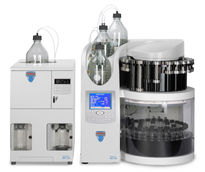Two-step chemical process turns raw biomass into biofuel
Taking a chemical approach, researchers at the University of Wisconsin-Madison have developed a two-step method to convert the cellulose in raw biomass into a promising biofuel. The process, which is described in the Journal of the American Chemical Society, is unprecedented in its use of untreated, inedible biomass as the starting material.
The key to the new process is the first step, in which cellulose is converted into the "platform" chemical 5-hydroxymethylfurfural (HMF), from which a variety of valuable commodity chemicals can be made. "Other groups have demonstrated some of the individual steps involved in converting biomass to HMF, starting with glucose or fructose," says Ronald Raines, a professor with appointments in the Department of Biochemistry and the Department of Chemistry. "What we did was show how to do the whole process in one step, starting with biomass itself."
Raines and graduate student Joseph Binder, a doctoral candidate in the chemistry department, developed a unique solvent system that makes this conversion possible. The special mix of solvents and additives, for which a patent is pending, has an extraordinary capacity to dissolve cellulose, the long chains of energy-rich sugar molecules found in plant material. Because cellulose is one of the most abundant organic substances on the planet, it is widely seen as a promising alternative to fossil fuels.
"This solvent system can dissolve cotton balls, which are pure cellulose," says Raines. "And it's a simple system — not corrosive, dangerous, expensive or stinky."
This approach simultaneously bypasses another vexing problem: lignin, the glue that holds plant cell walls together. Often described as intractable, lignin molecules act like a cage protecting the cellulose they surround. However, Raines and Binder used chemicals small enough to slip between the lignin molecules, where they work to dissolve the cellulose, cleave it into its component pieces and then convert those pieces into HMF.
In step two, Raines and Binder subsequently converted HMF into the promising biofuel 2,5-dimethylfuran (DMF). Taken together, the overall yield for this two-step biomass-to-biofuel process was 9 percent, meaning that 9 percent of the cellulose in their corn stover samples was ultimately converted into biofuel.
"The yield of DMF isn't fabulous yet, but that second step hasn't been optimized," says Raines, who is excited about DMF's prospects as a biofuel. DMF, he notes, has the same energy content as gasoline, doesn't mix with water and is compatible with the existing liquid transportation fuel infrastructure. It has already been used as a gasoline additive.
In addition to corn stover, Raines and Binder have tested their method using pine sawdust, and they're looking for more samples to try out. "Our process is so general I think we can make DMF or HMF out of any type of biomass," he says.
Most read news
Other news from the department science
These products might interest you

ERBAdry by CARLO ERBA Reagents
Anhydrous solvents from CARLO ERBA Reagents in a clever redesign
ERBAdry series impresses with the latest generation of septa and sealing caps

Thermo Scientific™ Dionex™ ASE™ 150 or 350 Accelerated Solvent Extractor systems by Thermo Fisher Scientific
Accelerated Solvent Extraction (ASE) – Maximize results and reduce errors in food analysis!
More extractions in less time using less solvent

Get the chemical industry in your inbox
From now on, don't miss a thing: Our newsletter for the chemical industry, analytics, lab technology and process engineering brings you up to date every Tuesday and Thursday. The latest industry news, product highlights and innovations - compact and easy to understand in your inbox. Researched by us so you don't have to.









![[Fe]-hydrogenase catalysis visualized using para-hydrogen-enhanced nuclear magnetic resonance spectroscopy](https://img.chemie.de/Portal/News/675fd46b9b54f_sBuG8s4sS.png?tr=w-712,h-534,cm-extract,x-0,y-16:n-xl)















































